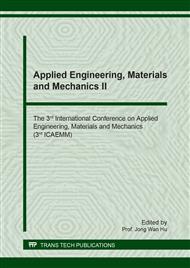[1]
W.R. Hendee, Cross sectional medical imaging: a history. Radiographics. 9 (1989) 1155–1180.
DOI: 10.1148/radiographics.9.6.2685939
Google Scholar
[2]
T. Watson., S. Young, Therapeutic Ultrasound. Electrotherapy: Evidence Based Practice. T. Watson. Edinburgh, Churchill Livingstone – Elsevier, (2008).
Google Scholar
[3]
H.T. Lutz, Basics of Ultrasound, in: H.A. Gharbi (Eds.), Manual of Diagnostic Ultrasound in Infectious Tropical Diseases, Springer Science & Business Media, Newyork, 2006, pp.1-19.
DOI: 10.1007/3-540-29950-5
Google Scholar
[4]
Information on https://www.accessdata.fda.gov/cdrh_docs/pdf13/K130581.pdf.
Google Scholar
[5]
M. Lertchaiporn, S. Klandima, A. Kruatrachue, T. Layangool, A. Pethdumrongsakul, A comparative study between new formulated and commercial ultrasound gel at Queen Sirikit National Institute of Child Health, Thai Pediatric Journal. 16(3) (2009).
Google Scholar
[6]
S. Luewan, K. Srisupundit, T. Tongsong, A Comparison of Sonographic Image Quality between the Examinations using Gel and Olive Oil, as Sound Media, J. Med. Assoc. Thai. 90(4) (2007) 624-627.
Google Scholar
[7]
R.L. Reis, N.M. Neves, J.F. Mano, M.E. Gomes, A.P. Marques, H.S. Azevedo, Natural-Based Polymers for Biomedical Applications, 1st Edition, in: R.A. DE Sousa, V. Correlo, S. Chung, N. Neves, J. Mano, R. Reis (EDS.), Processing of starch-based blends for biomedical applications, Elsevier, New York, 2008, pp.85-105.
DOI: 10.1533/9781845694814.1.85
Google Scholar
[8]
J. Waterschoot, S. V. Gomand, J. K. Willebrords, E. Fierens, J. A. Delcour, Pasting properties of blends of potato, rice and maize starches, Food Hydrocoll. 41 (2014) 298-308.
DOI: 10.1016/j.foodhyd.2014.04.033
Google Scholar
[9]
Information on https://www.thairiceexporters.or.th/List_%20of_statistic.htm.
Google Scholar
[10]
V. Vongsurakrai, S. Varavinit, Product of Spray Dried Rice Starch (Era-Tab®) and its Utilization in Pharmaceutical Industry, Adv. Mat. Res. 93-94 (2010) 672-674.
DOI: 10.4028/www.scientific.net/amr.93-94.672
Google Scholar
[11]
G. J. E. Nychas, E. Panagou, 1 – Microbiological spoilage of foods and beverages, Food Beverage Stabil. Shelf Life. (2011) 3-28.
DOI: 10.1533/9780857092540.1.3
Google Scholar
[12]
C. G. Arvanitoyannis, H. Biliaderis, N. Kawasaki, Biodegradable Films Made from Low Density Polyethylene (LDPE), Rice Starch, and Potato Starch for Food Packing Applications, Carbohydr. Polym. 36(2) (1999) 89-104.
DOI: 10.1016/s0144-8617(98)00016-2
Google Scholar
[13]
N. Laohakunjit, A. Noomhorm, Effect of Plasticizers on Mechanical and Barrier Properties of Rice Starch film, Starke. 56(8) (2004) 348-356.
DOI: 10.1002/star.200300249
Google Scholar
[14]
J. Sun, X. B. Zuo, S. Fang, H. N. Xu, J. Chen, Y. C. Meng, T. Chen, Effects of cellulose derivative hydrocolloids on pasting, viscoelastic, and morphological characteristics of rice starch gel, J. Text. Stud. 48(3) (2017) 241-248.
DOI: 10.1111/jtxs.12233
Google Scholar
[15]
D. Saha, S. Bhattacharya, Hydrocolloids as thickening and gelling agents in food: a critical review, J. Food Sci. Technol. 47(6) (2010) 587-597.
DOI: 10.1007/s13197-010-0162-6
Google Scholar
[16]
P. Nagaraj, A. Sasidharam, V. David, A. Sambandam, Effect of Cross-Linking on the Performances of Starch-Based Biopolymer as Gel Electrolyte for Dye-Sensitized Solar Cell Applications, Polym. 9(12) (2017) 667.
DOI: 10.3390/polym9120667
Google Scholar


